Social Media Account Curates Bizarre Oddities From Human History
The truth is often more bizarre than fiction. Every day, strangeness surrounds us — on the web, on public transportation, even in our own imaginations. We may even confidently assert that we have continuously been residing in a prolonged episode of Black Mirror after having taken a long, hard look through the hazy black-and-white distortion into the centuries and decades that happened before us.
We typically find such oddities in museums, but one Twitter account has become a digital curator and created a Museum of Curiosities for all to enjoy. Managed by the musical group Monsieur Pompier’s Travelling Freak show, @CuriosMuseum is full of strange, vintage devices, trinkets, and clothing, as well as perplexing goods, advertisements, inventions, and more. So sit back, relax and enjoy this bizarre ride through time!
Ye olde booke browser
People take it for granted that, when we want to search for new information at any time, we can simply open a new tab in a web browser. Even if you’re reading a physical book, you can open as many internet tabs as you want to cross-check facts, trivia, etc.
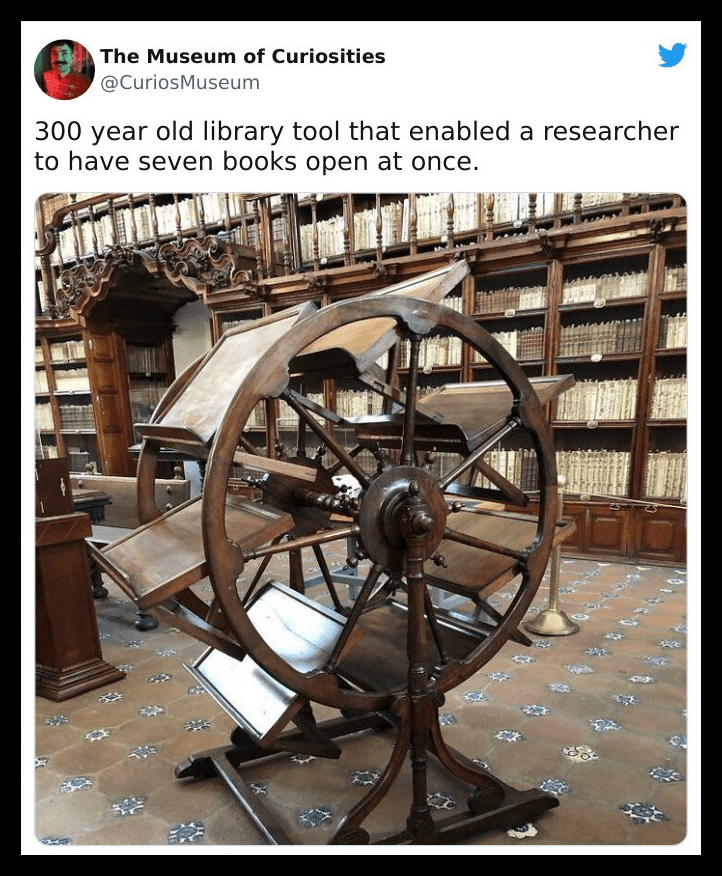
Yet we keep forgetting how tough life was in the past. How did they research information before infinite tabs were available? This 300-year-old library device was the original “too many tabs open.” It enabled users to have seven books accessible at once!
Wonder Truck prophecy
Street food is not a new phenomenon, but throughout the late 17th century, it was a vital source of food for many people, especially in urban areas. With small kitchens in their homes, people relied on these street vendors for fresh, home-cooked meals.
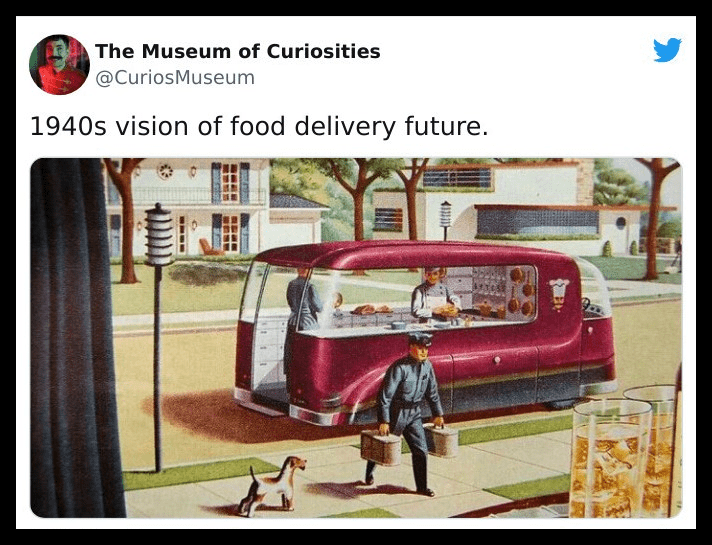
Even as society advanced, the desire for quick, easy food on lazy days didn’t disappear. We have food delivery services UberEats and DoorDash, and now even restaurants on wheels, like Wonder Truck. Do you think this image is a prophecy or just an inspiration?
Steam trunk and dresser: 2 in 1
Hauling this monstrosity of a steamer trunk would have been a real pain in the behind. But it was undoubtedly convenient, especially when most of the long-distance travel was done by ship and you had to be at sea for months on end.

What’s so good about it? It opens up to form a dressing cabinet, so it cuts out the hectic unpacking. And if there were no dressers available, owners of these 2-in-1 devices didn’t need to worry. It was all about what one could do with what little was available, back in the day.
Pass!
Unless you want to look like a cartoon villain or are going to cosplay as Harley Quinn, we suggest ditching these. It’s no wonder these were even thought of as a fashion statement in the sixties, given the prevalence of the hippy love vibes in that decade.
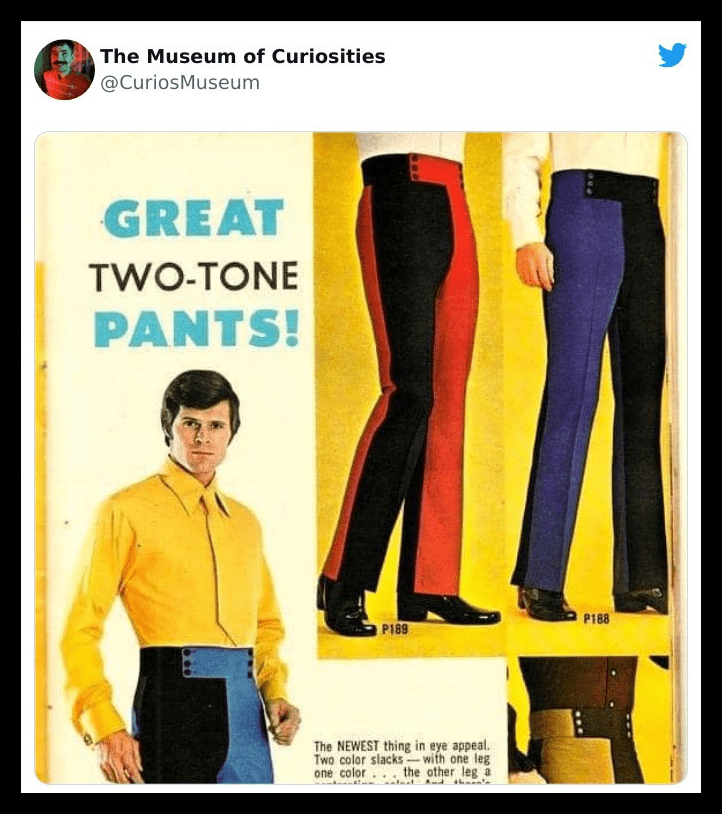
This is right on par with those futuristic clothes predicted in the 60s, which are ultra-sleek, bright, and translucent, or chrome. For some reason, that’s how humans envisioned they would appear. Also, loud colors! Orange? Check. Yellow? Check. Shades that practically nobody should ever use as lipstick? Check!!
1950s Electronic Music Box
While working at the C.G.Conn Ltd. Company, USA, to construct electrical organ circuits, Dr. Earle.L. Kent created The Electronic Music Box as a personalized synthesis and composing tool. The Music Box seems to have been a punched card strip-operated analog “beat frequency” vacuum tube synthesizer.
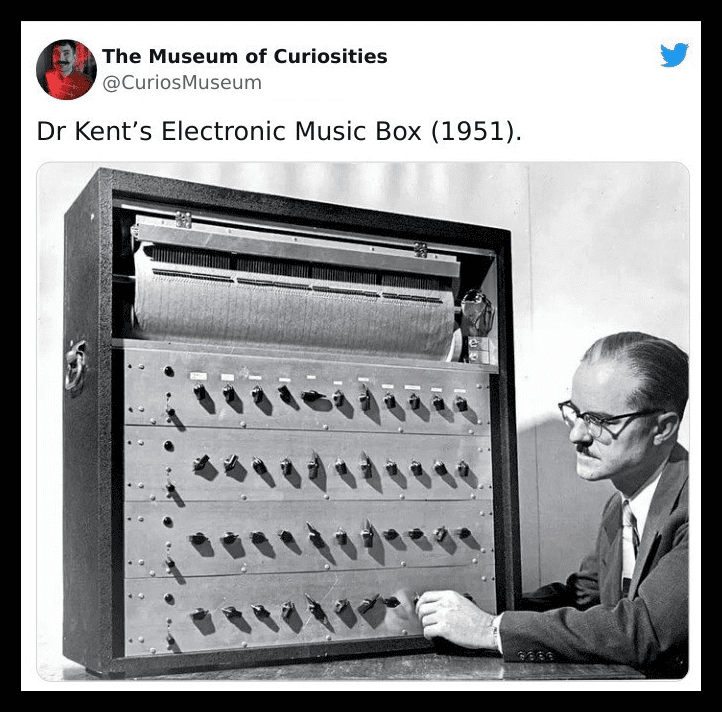
In order to produce a more intriguing spectrum of timbre and have complete leverage over note shape, Kent’s device made use of an increasingly sophisticated set of frequency shifters. Basically, it’s a retro iPod. Imagine John Cusack in Say Anything lugging this around.
A shoe-in for the quirkiest sidecar award
Some of the craziest, most outrageous, silliest, and also most insane sidecars in the world are the result of creativity, mocking, insanity, and complete disrespect for the fundamental safety regulations for motorcycles. Add a good dose of fun to the mix.
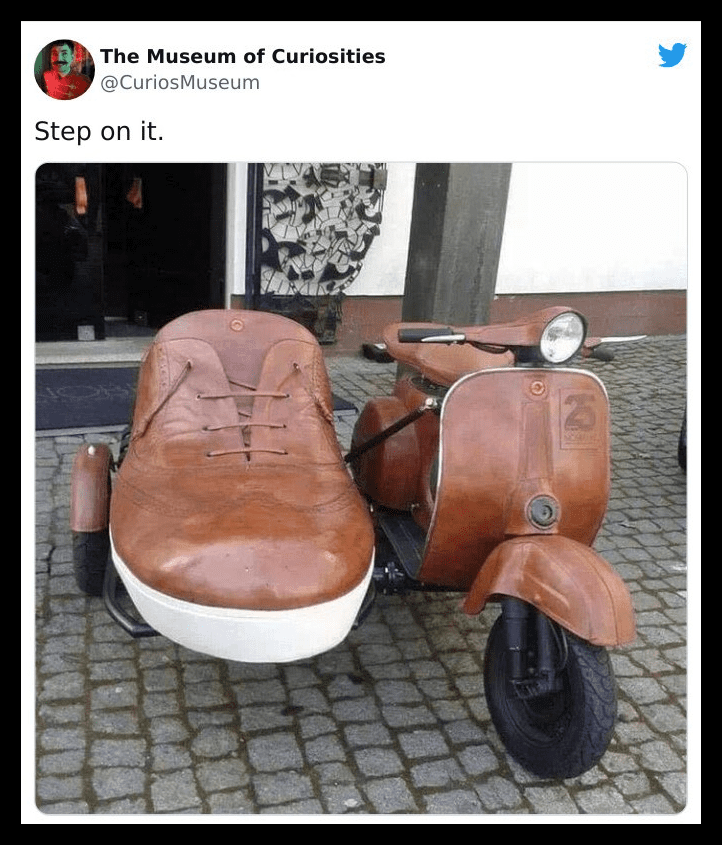
This amazing sidecar is mounted on what appears to be a scooter similar to a Vespa. Our best guess is that the shoe sidecar belongs to a reputed shoemaker, and this is his own take on marketing his wares. That’s the only logical explanation we can think of.
Frog-themed coin purse
We wonder if this were to be bestowed with a kiss if it would turn into a prince. That’s the underlying principle, isn’t it? Or, perhaps that only works with real frogs, in which case this frog-shaped coin purse is just immutably charming.
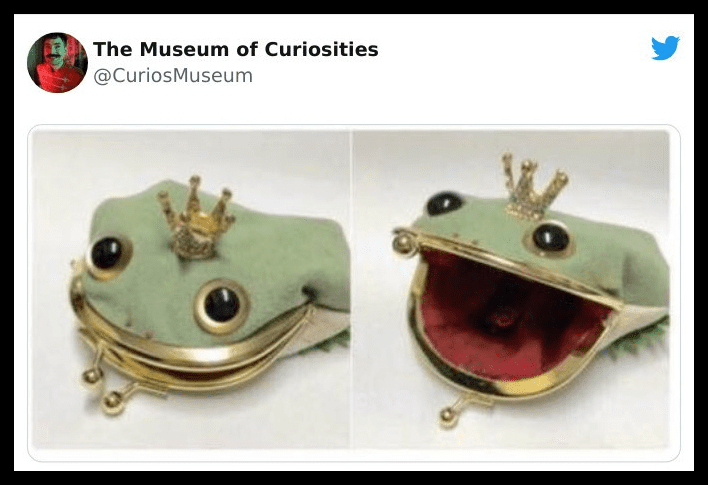
Though, that big crown makes it rather impractical if it were to be carried in a satchel or a handbag. But on the other hand, like an old-timey grandmother, it would have its appeal. It all boils down to the user at the end of the day.
Corner piano
There’s no explanation for how this could have functional keys. Sure, the ones toward the sides might be semi-playable, but the closer to the corner, the harder the keys are to reach. And how would you even sit? It seems like a swivel chair would be necessary.
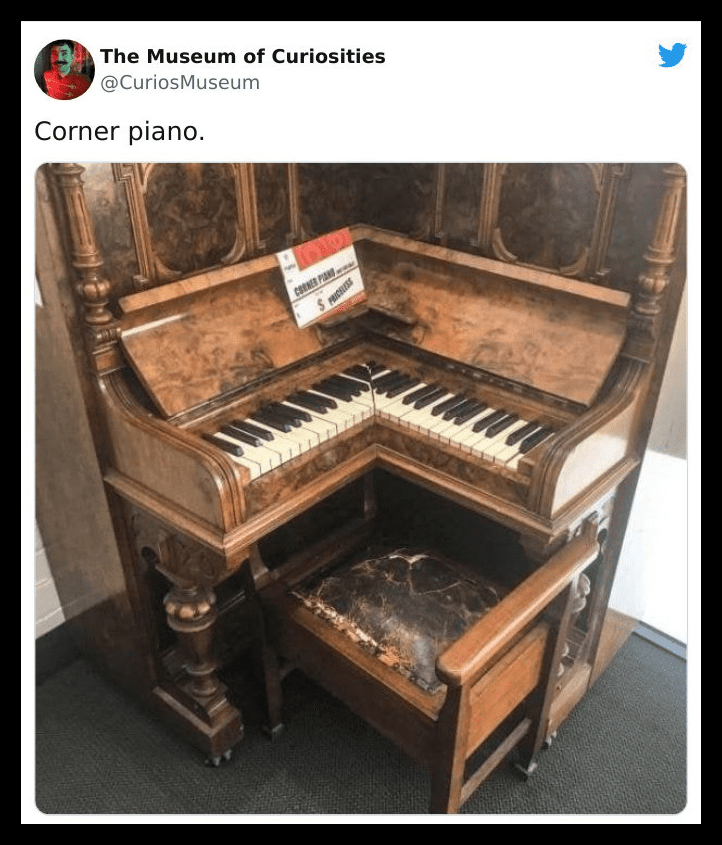
Without a little rearrangement and modifications, the pedals definitely wouldn’t function. Manufacturing the piece is possible, but its practicality is out of the question. So, it is a conversation piece at best. Still, we’re curious what an attempt at playing it sounds like.
Chinsekikan, Japan
There is a stone museum named Chinsekikan in Chichibu, two hours northwest of Tokyo. You won’t learn anything about geology there, however, you’ll have a great time taking in odd exhibitions. For example, the Elvis Presley rock, the Donkey Kong rock, and the Jesus rock are on display for all to see.
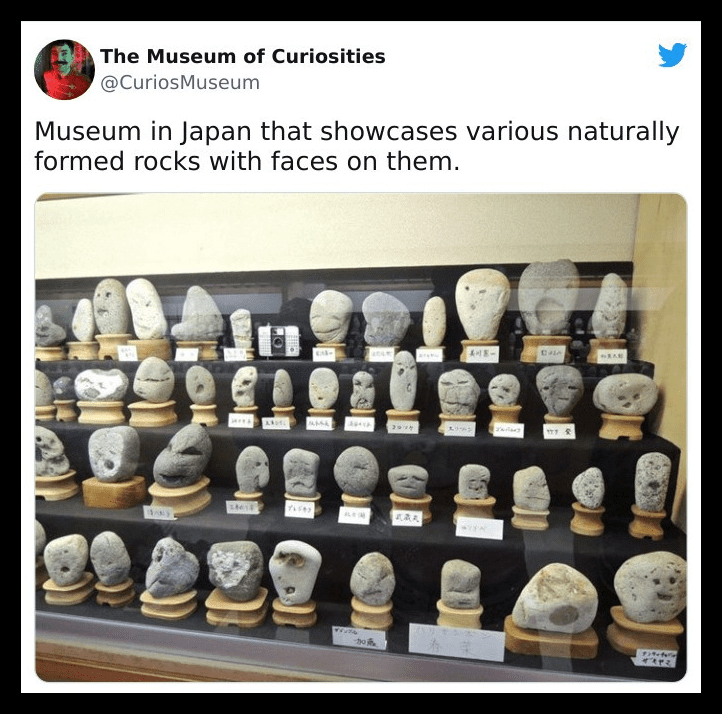
The “hall of unusual rocks” contains more than 1700 specimens. 900 of them have features that mimic human features, many of whom are recognizable famous people, religious figures, fictional characters, and much more. The natural likeness of these untouched rocks is what makes them so amusing.
Baby rattle from the 1930s
According to historical accounts, the baby rattle was invented around 2,500 years ago. One of the oldest instances of a baby rattle was discovered in Poland and dated back to the Iron Age. Of course, it goes without saying that they looked very different from what we know today.
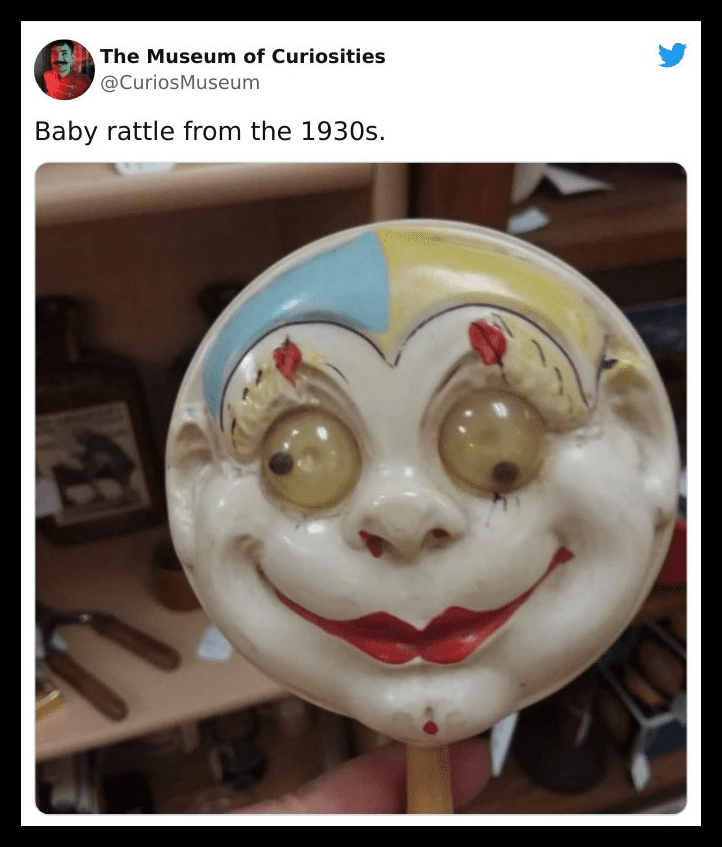
While some things looked better back in the day, we can’t say the same about baby toys. This rattle looks like it was designed by Pennywise the clown and its sole intention is to give kids nightmares. We’re glad that the designs have changed over the years.
Bat-shaped lantern
Now this, for sure, must be somewhere in the Wayne Manor. If you would think Bruce Wayne wouldn’t buy this in an instant, then you are sorely mistaken. It’s like it was made to adorn the Batcave, don’t you think?
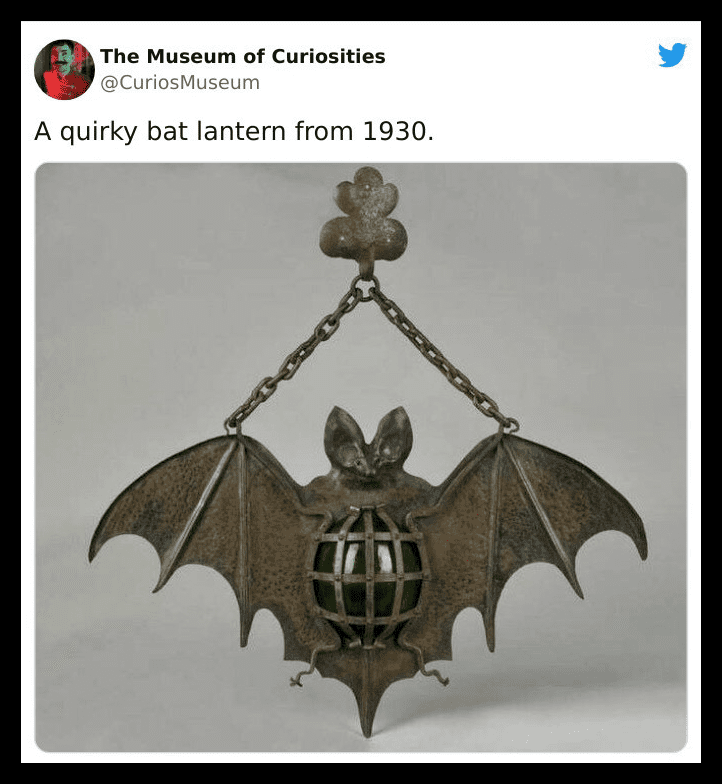
The Twitter account credits this to the 1930s, but we could imagine seeing this in earlier centuries. What other bat-themed pop culture icon is there? Dracula, of course. It does have the medieval craftsmanship look that makes one think it is from Transylvania.
The ancestor of the Roomba
Robotic vacuum cleaners are known by many names, though the concept is always the same: they autonomously clean a given space. You might even have one yourself. They have improved in efficiency, power, and even sterilization over the years, and there is no denying their convenience.
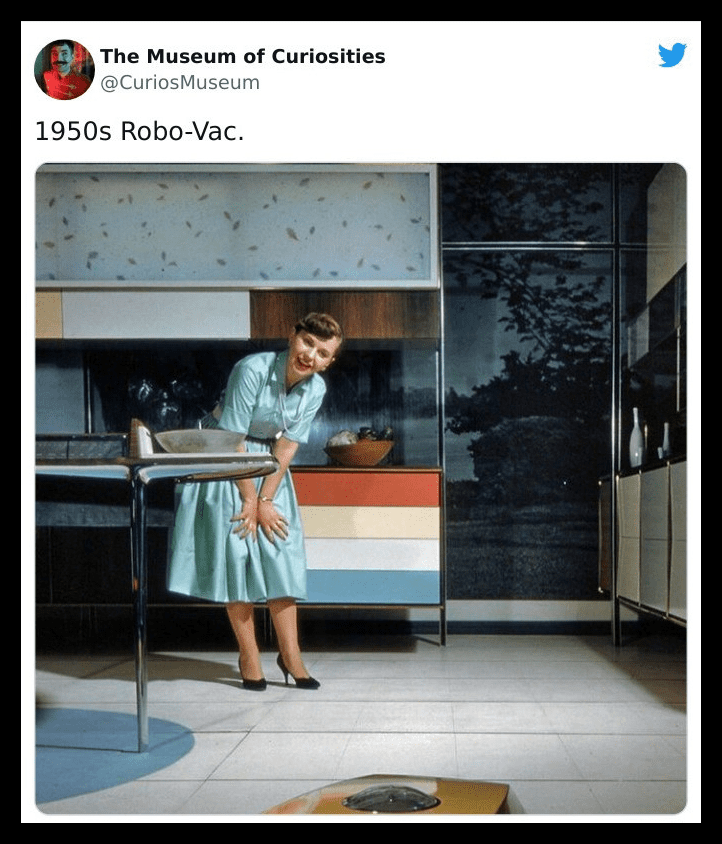
Nowadays, some go beyond simple vacuum cleaners and even include surveillance cameras, intercom systems, and other functions. In 1996, the first robotic vacuum cleaner debuted, so this can’t be a functioning Robo-Vac from the 50s. Given its likeness to the mobile food truck, we’d guess that this is another “vision of the future” ad.
Pennywise chalks
This sure does give us anxiety. It is a clever use of the whiteness of the chalk to emulate the teeth of the clown, but the same thing tends to awaken a deep-seated phobia of clowns — if you catch our drift.
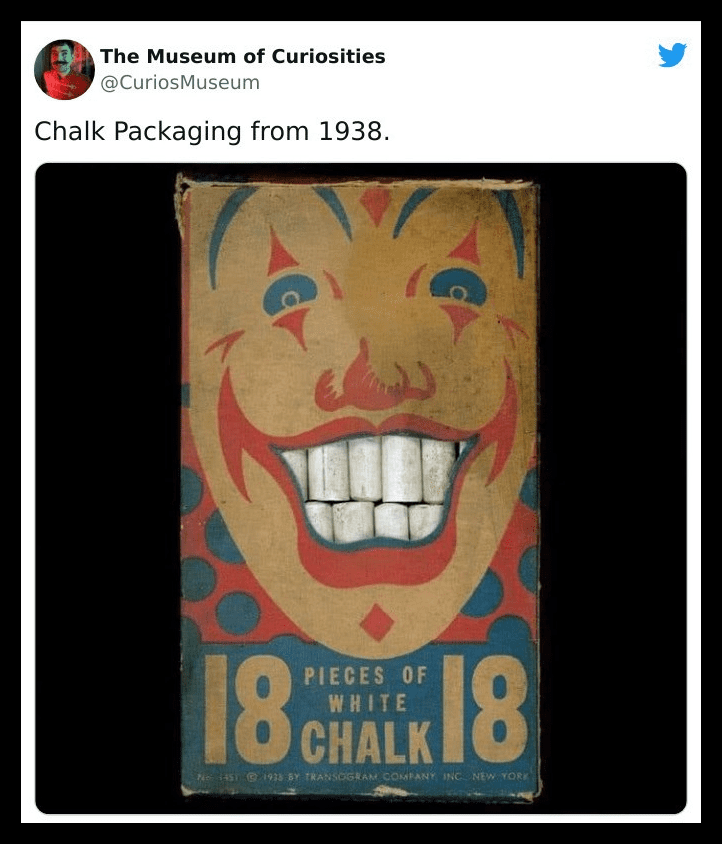
It kind of looks like the mouth of Sauron from the Return of the King. Either there were fewer instances of coulrophobia in the 1930s, or it was products like this that instilled such a fear in people. What do you think?
“Metal” teapot
Man, that’s one stunning depiction of what seems like an Elwetritsch. An Elwetritsch is a cryptid and is described as having a chicken-like appearance, but also with antlers and scales in place of plumage. Notably, it is stated that its wings are of no use.
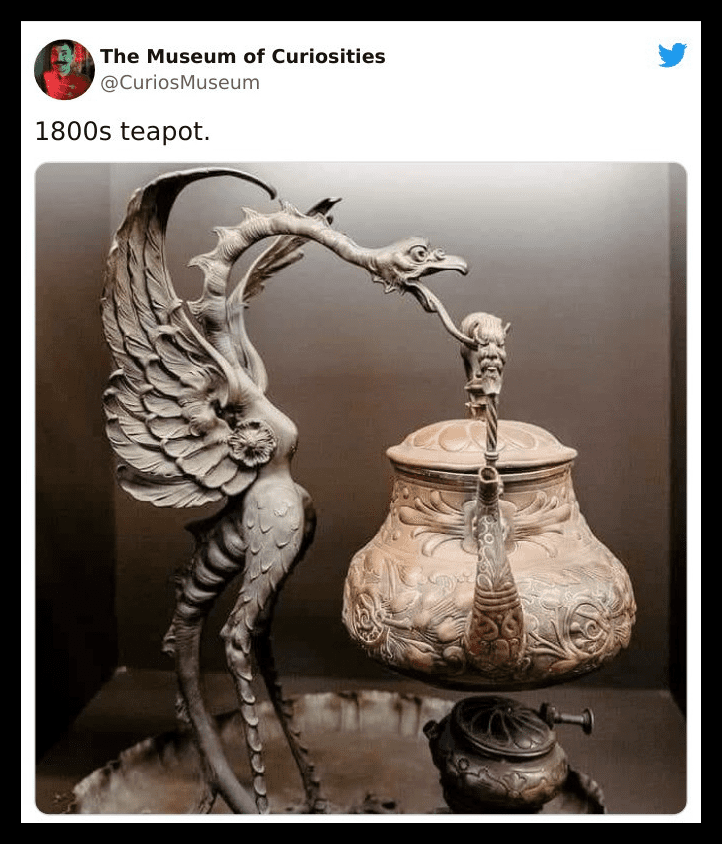
They like to live in bushes or under vines. The Elwetritschen is occasionally shown with stag-like antlers, and their beaks frequently have a lengthy appearance. While this teapot seems oriental at first glance, if this is an Elwetritsch, it’s probably European-made.
Life imitates art
Sometimes, things in the world align in such a way that they become so on brand. Like this Alice’s Adventures in Wonderland book, which got moisture damage to the point where it sprouted mushrooms on it. Some of you might pick up why this is so perfect…
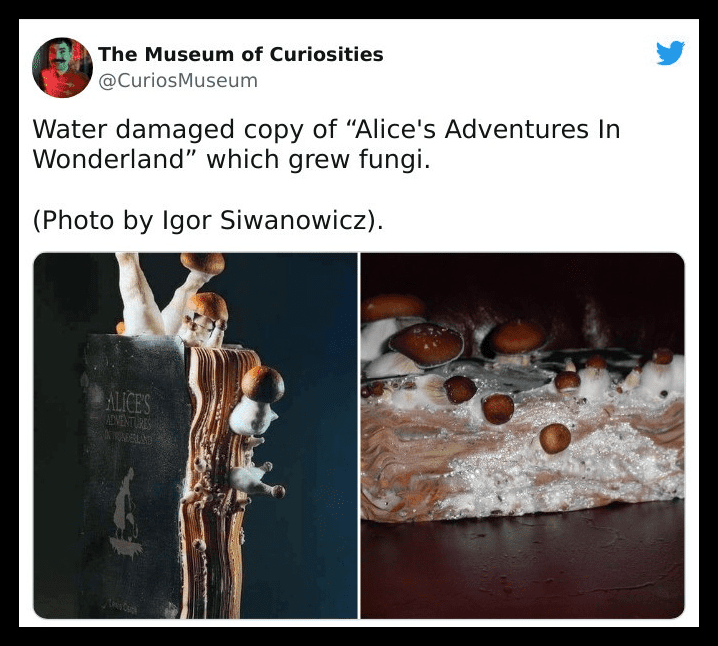
The whole book feels like a hallucinogenic experience reserved for the most potent of compounds. Since certain kinds of fungi are known for their psychoactive properties, this seems like nature read the book and was inspired to make its own depiction of the stories.
Cat painting to end all cat paintings
Now, this seems like the kind of painting that we want hanging in our house. It seems like the cat version of the famous Dogs Playing Poker painting. Much like that one, if you pay close attention, you will notice that a lot of things are occurring in the background.
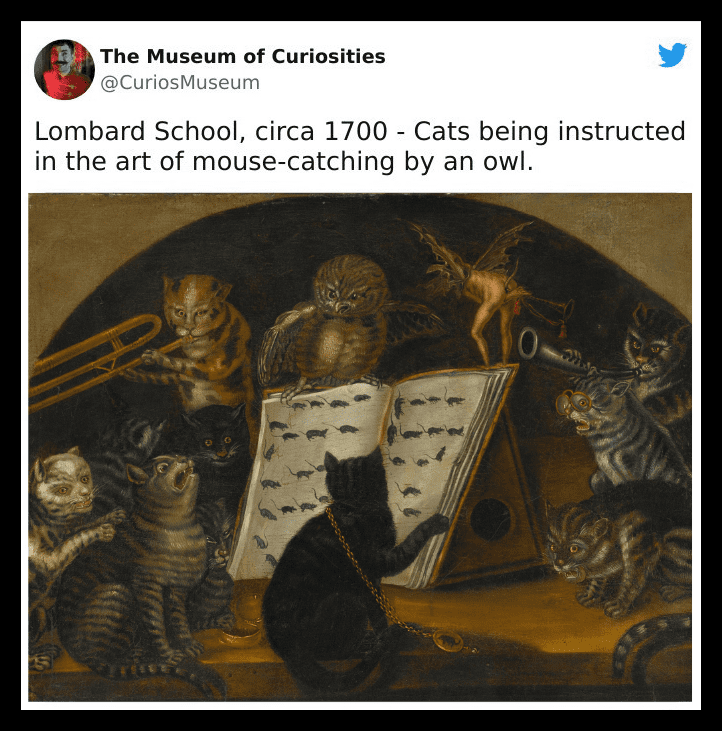
According to the official descriptor, the image depicts an owl teaching cats how to catch mice. But we agree with the alternate interpretation that it’s a cat orchestra, featuring an owl and an odd devil playing the clarinet from its behind.
A book containing a bookcase — 18th century
This is book-ception. It’s a bookcase full of books hidden within a bookcase! This piece was essentially created by a Swedish bookbinder and given as a present to a Dutch noble. Titles include Christian prayers for Dutch youth and Core Dutch History.
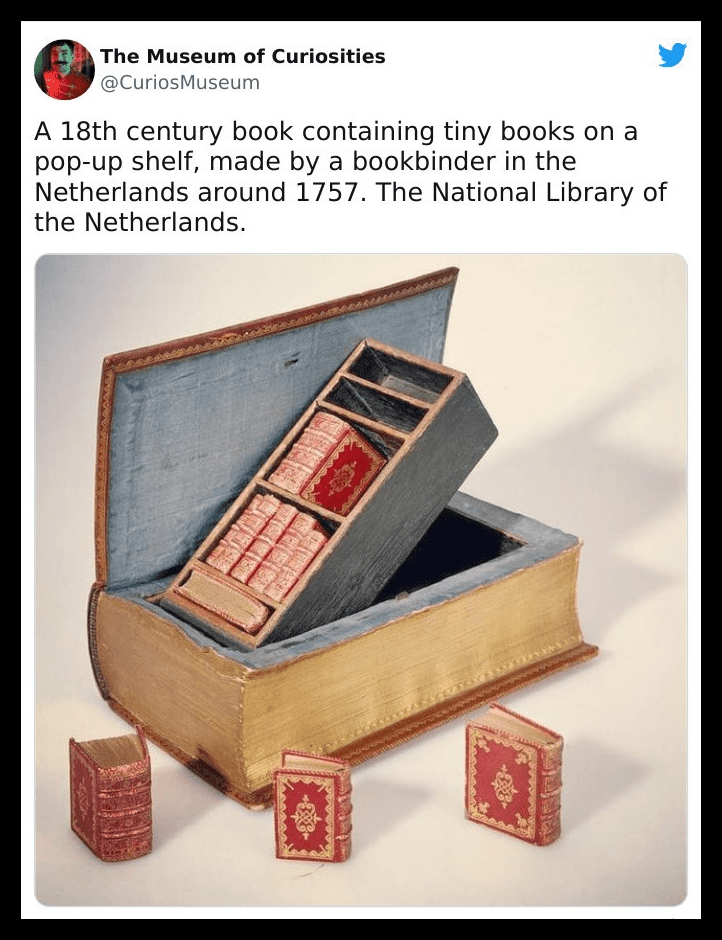
Some of the works seem to be Bible in Verse (in French), Bible Old and New Testaments (in Dutch), Core Bible Passages, Core Church History, and The New Spiritual Songbook. There are nine books in total but only seven titles are mentioned online. We wonder what’s in the other two.
Intricate radiator
Before the Victorian era, radiators were simply warmers. Over the years, they became accent pieces that people would be happy to have on display where the warmth would reach the whole room. Since then, the cast iron radiator has grown in popularity amongst interior designers.
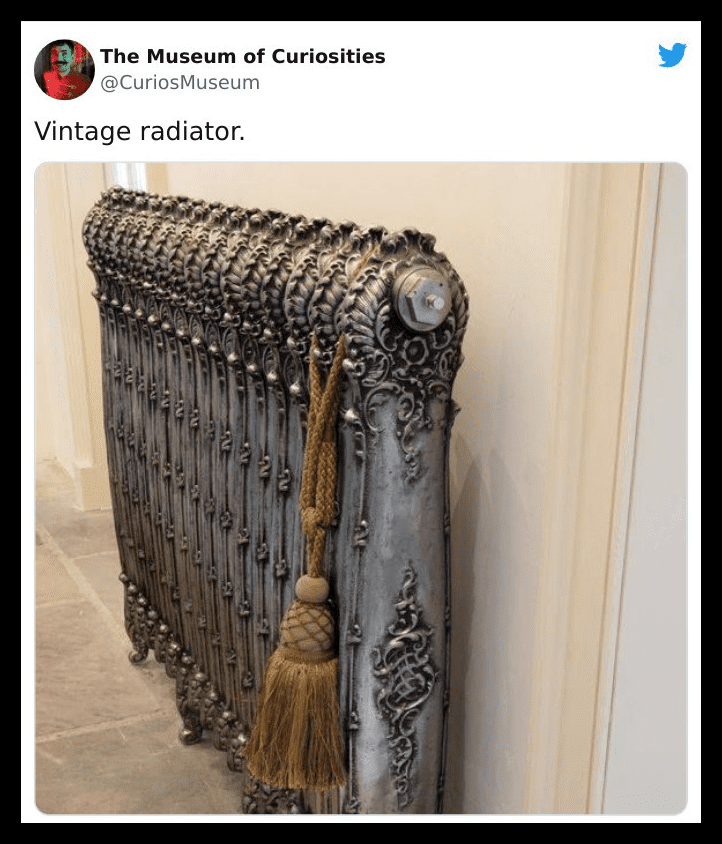
This is despite the fact that many individuals at the time considered it to be too cumbersome for regular usage. Just look at the thing. We can’t imagine anyone moving it once it was installed. And we don’t want to think about the safety hazard that it posed.
Futuro House by Matti Suuronen
No, this is not from a Hollywood set. In the late 1960s and early 1970s, around 100 of Finnish architect Matti Suuronen’s Futuro prefab houses were constructed. Today, the dwellings are in high demand among enthusiasts and Airbnb guests due to their design.

Its spaceship likeness and airplane hatch entryway just add to the apeal. The 13 feet high and 26 feet wide Futuro was made of fiberglass-reinforced polyester plastic, polyester-polyurethane, and poly(methyl methacrylate). Sadly, the company was shut down and we won’t see more Futuro buildings in the future.
Antique disguise kit
This collection reminds us of the Groucho glasses. Remember those? Groucho glasses, often referred to as nose spectacles, the beaglepuss, or perhaps the GM 20/20s, are a parody of the heavy makeup worn mostly by comedian Groucho Marx in his films and theatrical appearances.
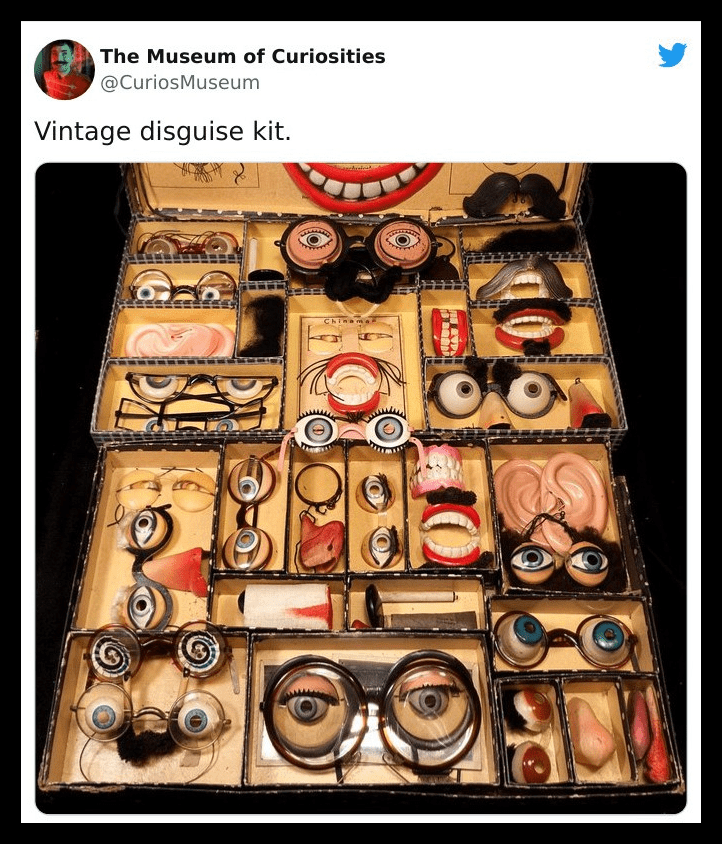
They are a comical gimmick disguise, such as the ones you see here. Groucho glasses have been promoted as early as even the 1940s and are readily available to individuals all over the globe. They are among the most famous and popular novelty goods in the world.
Hood certified Tricycle
The steel structure of the 1936 Sky King tricycle was built according to aerodynamic principles. This one was titled after an action television program called Sky King. It was about an aviator, and the show was produced by the Canadian toy firm Junior Toy Corporation.
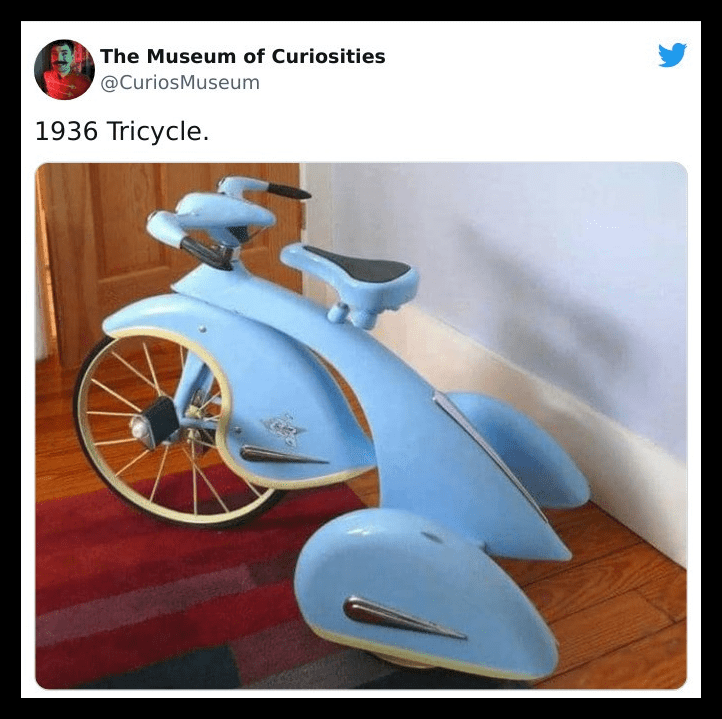
This is nothing like the trikes we know today. Replicas built in Taiwan cost about $345, while the authentic 1936 ones sell for over $3,000. This is by far the most G tricycle we have ever come across, in any era. And that is saying something.
Force field or cellophane?
In the category of “creative exit signs,” this takes the cake. Though, there’s one major problem: the sign guy is going the wrong way. He seems to be trapped by an impenetrable force field and can’t escape the safety zone behind him.
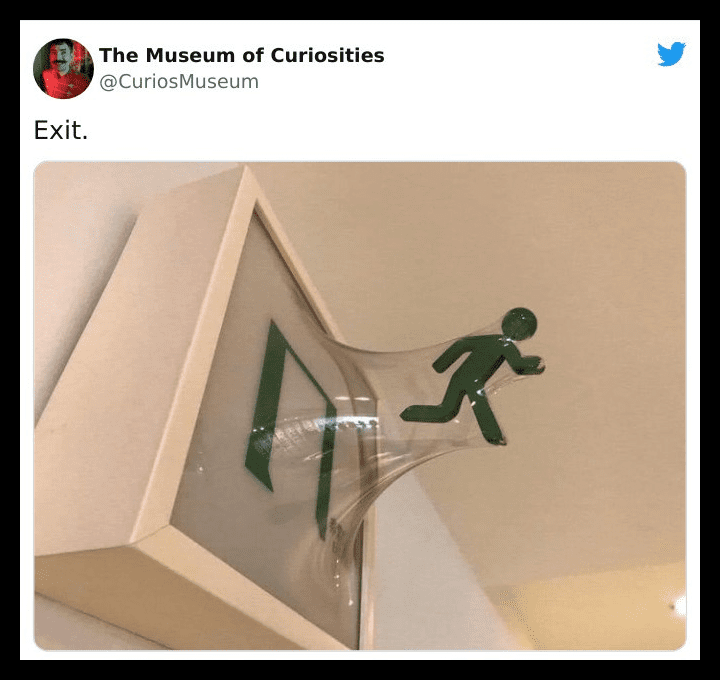
But in a world where people push when they should pull, and pull when they should push, this seems rather appropriate. It’s quite illustrative and the room for error is quite low when you consider all aspects. After all, you want the exit sign to be eye-catching.
A musical typewriter
Although music typewriters were created mostly in the 19th century, it was not until the middle of the 20th that they gained widespread acceptance. Utilizing these devices is typically a specialty for performers. Although many different models were developed, two particular ideas ended up being the norm.
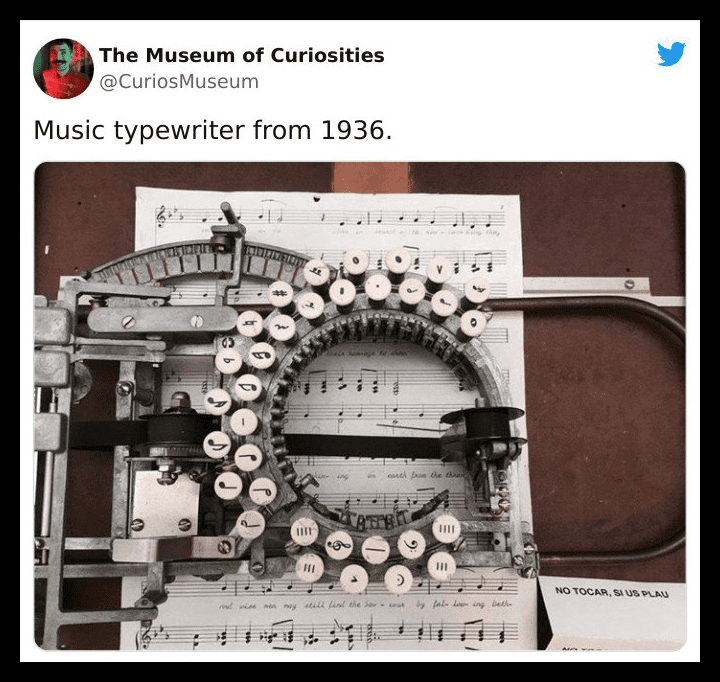
A typical typewriter’s appearance was quite distinct from the Keaton Music Typewriter. This had two keyboards: a mobile keyboard and a fixed keyboard. Pretty convenient if you happen to be a composer. It can’t be easy writing all those clefts all the time.
Two tasks, one radiator!
Remember what we said about dual-function radiators making an appearance during the Victorian era? This right here is the perfect example. Not only does this system keep the house warm on cold European nights, but it also keeps the bread warm and toasty.

Not everyone has the luxury of space, both then and now, so appliances with two functions are always a hit. In fact, with devices like radiators, it seems like a waste to only have one purpose. The Victorians were really onto something here.
1930s Art Deco dressing table
A movement of visual art, architecture, and product innovation, Art Deco — short for the French Arts Décoratifs — was born in France in the 1910s. This flourished both inside the United States and throughout Europe in the 1920s and 1930s.
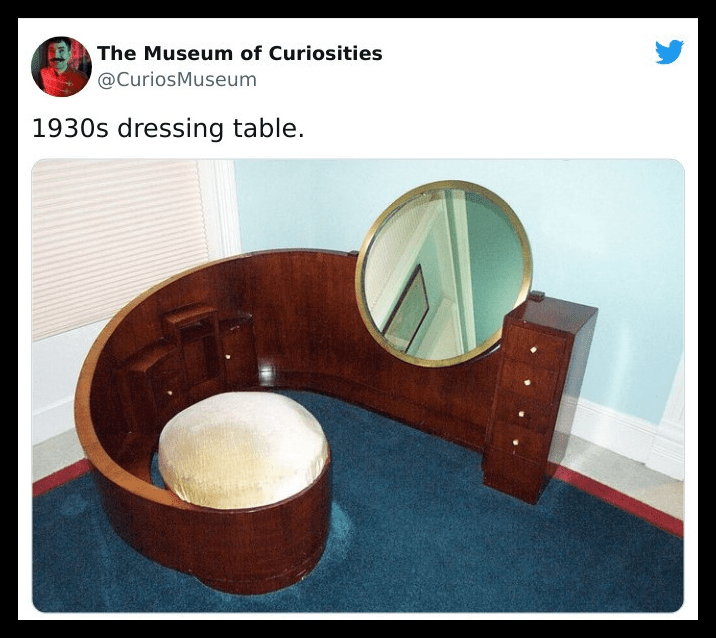
Art deco ideas were applied through the aesthetic and style of the outside and inside of anything, encompassing people’s appearances, ranging from enormous buildings to tiny items. It was the sort of movement which saw the artistic side in everyday items.
The topiary maze found at the Pazo de San Lorenzo
Topiary is the horticultural art of shaping perennial vegetation into elaborate or simple geometric forms by pruning the leaves and limbs of trees, shrubs, and subshrubs. The phrase also describes the plants themselves that have undergone such shaping. In essence, topiary refers to a kind of living sculpture.
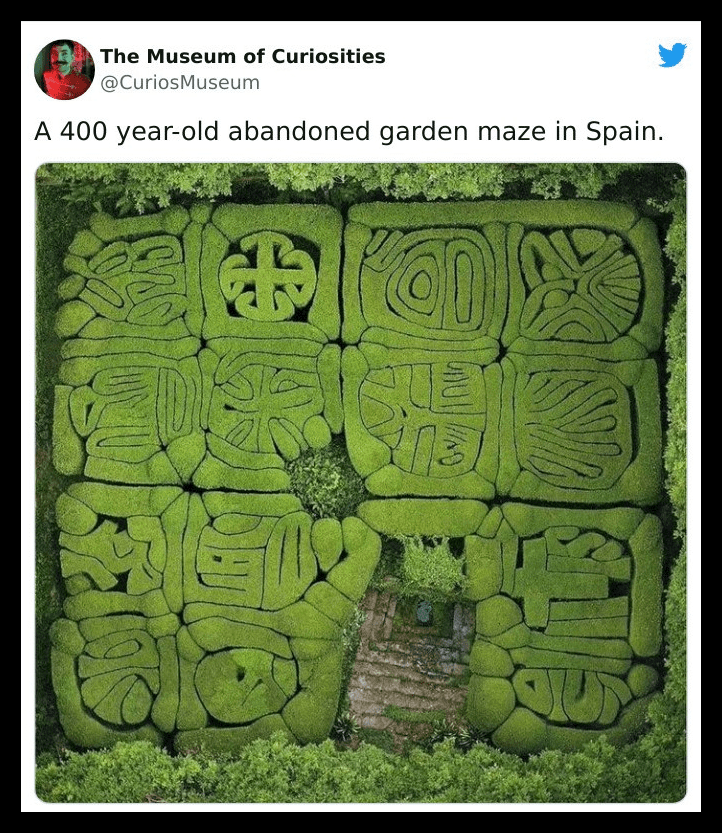
Also, it is quite aesthetic. The term is derived from the Latin term “topiarius”, which refers to a designer of topia, or “places,” in a beautiful landscape. Though it’s worth noting that CuriosMuseum is a bit wrong here; this topiary maze, found at Pazo de San Lorenzo, is very much in use.
Memorandum device from the 1950s
Today, many of us use our phones as notepads. We’ll admit to using it to write down our grocery list; it’s more accessible and won’t get lost so easily before our next grocery trip. But before phones, notepads worked well, too.
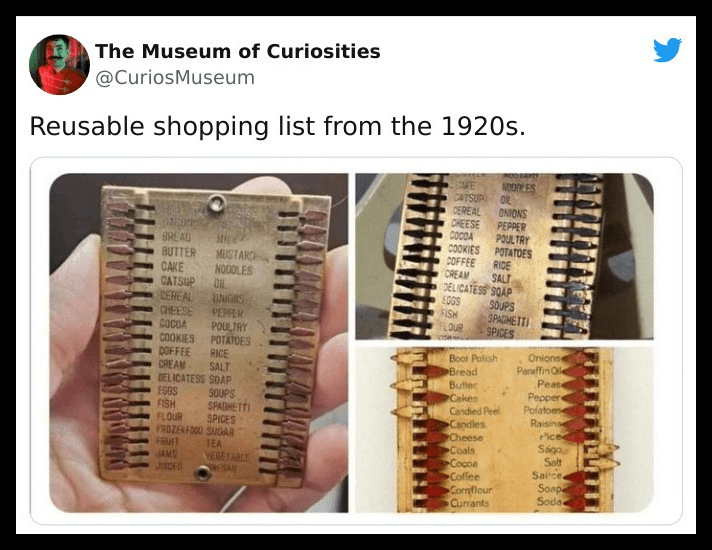
But in the 1950s, there wasn’t as much scrap paper to go around. The solution? A reusable grocery shopping list that could easily fit in one’s pocket. It’s weighted enough that it wouldn’t be lost as easily as a slip of paper, either.
Victorian mirror sculpture — Michael Locascio
Designer and proprietor of Dellamorte & Co, Michael Locascio, resides in New Jersey and creates frightening and morbid artworks that are inspired by fantastical beings, dungeons, and mystery. Michael is experienced in the field of sculpting, having studied it at the Newington Cropsey Foundation.
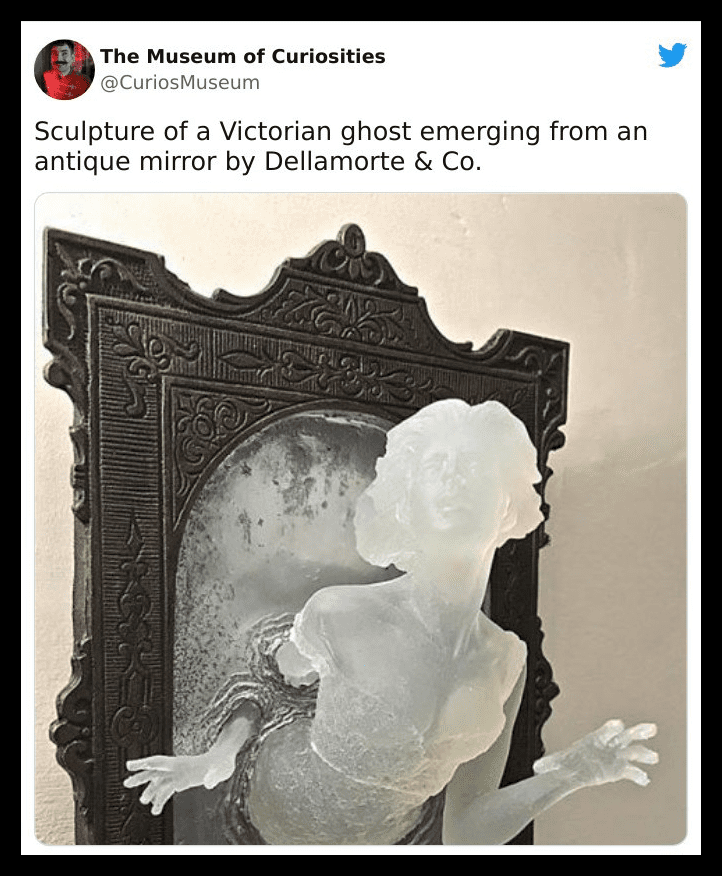
Skilled or not, this is not the kind of thing you would want to run into in the middle of the night. The attention to detail is outstanding, and a half-asleep brain might mistake this for a real ghost, especially if it was a new addition to the home.
Late 19th-century reading station
Built out of mahogany, this unique piece has a double wingback chair, including an arm divider, is upholstered in green hide plus close-nailed tacking, has a book stand that can be adjusted, and is backed by trimmed lobed legs that end in castors.
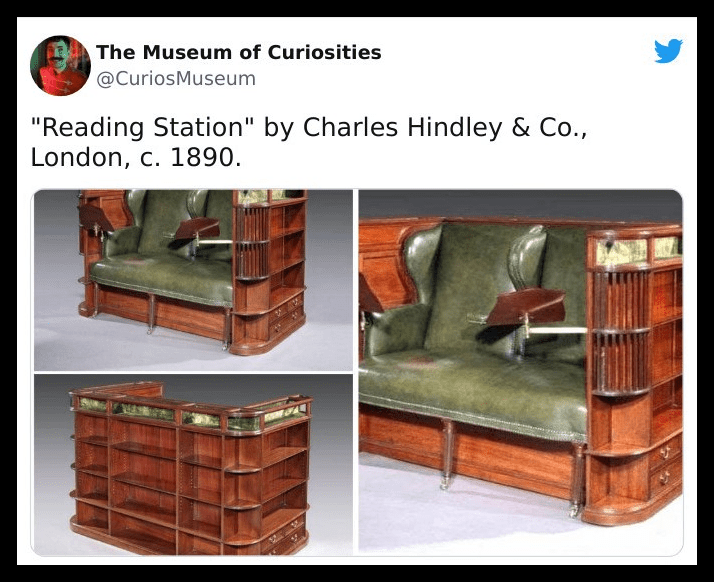
The entire piece is enclosed in a three-quarter surround that has exhibit bays, cubbies, and extendable bookcases. The manufacturer’s mark reads “Charles Hindley, Welbeck Street.” Now, this is something any book lover would jump at buying…until they see the price tag on this thing.
L’Orange Variee cologne
This perfectly designed perfume bottle was created in 1925 for the “L’Orange Variee” cologne by Les Parfums de Marcy. The fragrance is packed in eight distinct glass compartments that are each shaped like an orange segment resting inside a colored enamel peel.
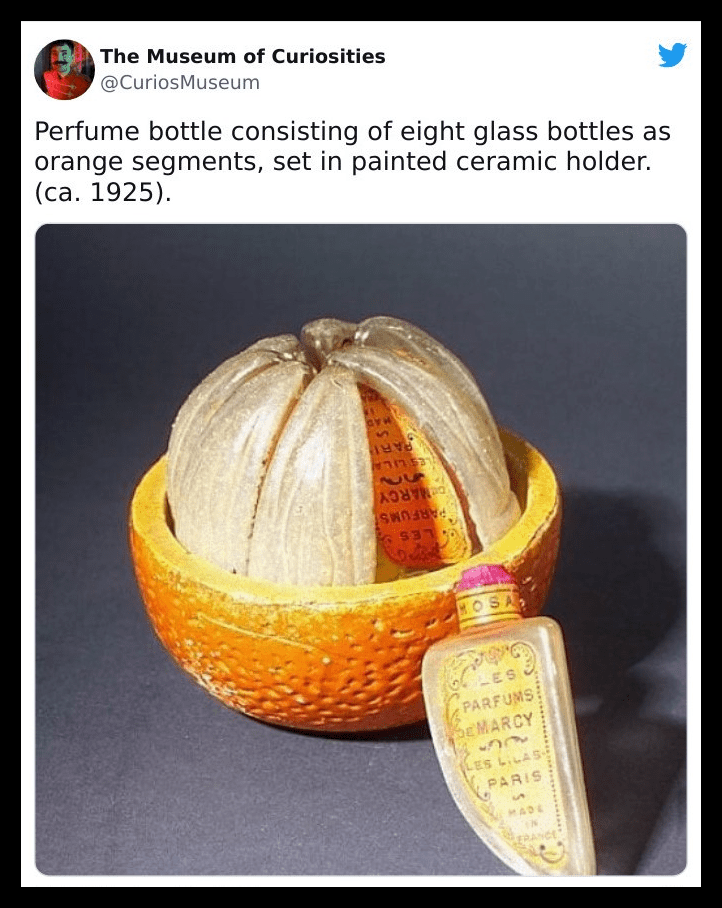
That’s to hide the corks. Although eccentric perfume bottles such as this were common throughout the 1920s, one with a citrus form was still somewhat unique. Due to a large number of fragile components, it is incredibly uncommon to locate a whole, intact specimen today.
Egyptian/Phoenician glass bead
There are certain types of art that date back as old as we can trace history. We all know about cave paintings and clay sculptures, but glass works could be found thousands of years ago. CuriousMuseum shared a lovely, ancient glass bead. Check it out.
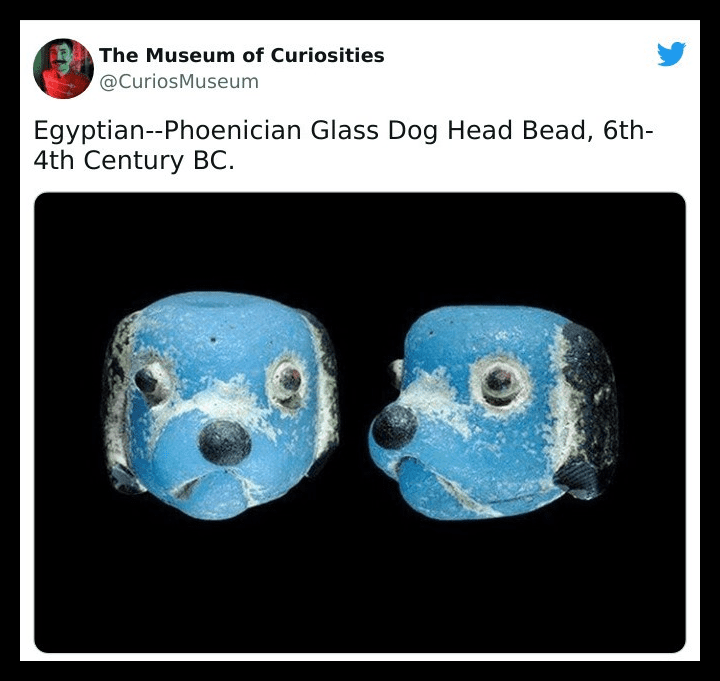
The Phoenicians imitated ancient Egypt’s glass manufacturing, particularly in the towns of Tire and Sidon, before developing it into mass production. Just look at the details of this dog head. It looks modern enough to be considered a forgery. What master craftsmen our ancestors were.
48 Shades of the Moon
We commonly associate the moon with a greyish color, but reds and yellows are rare, albeit known, “variations.” In fact, there’s a whole spectrum of the moon’s colors. Thaks to NASA’s technologies, they’ve put together a moon color wheel, of sorts.
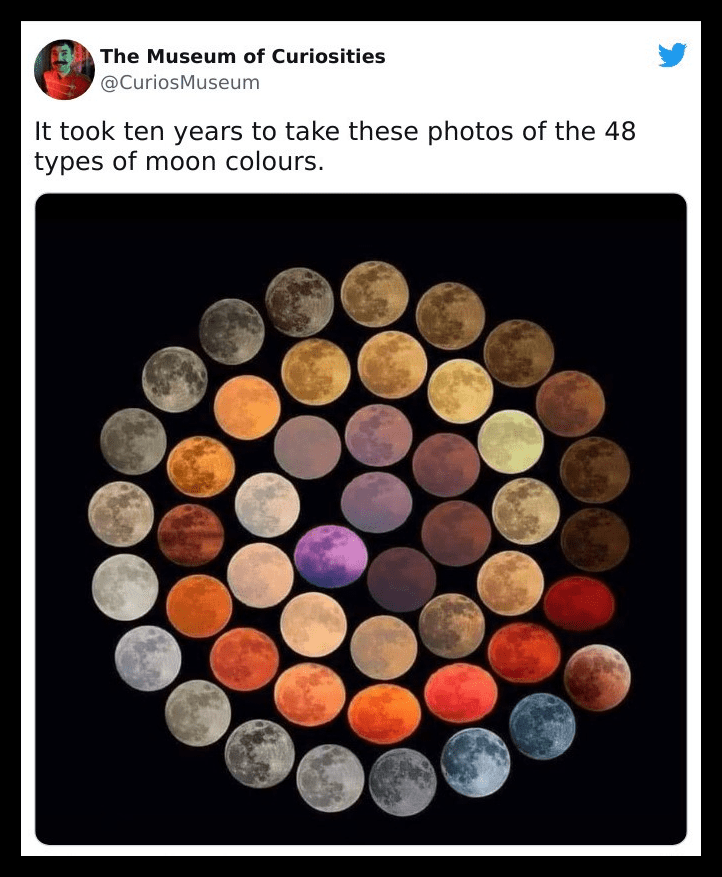
A red or yellow moon viewed from inside the Earth’s atmosphere means a moon close to the horizon. A blue moon is viewed through an atmosphere holding larger dust particles. The purple moon could be a result of a variety of factors.
Extensive collection of walkmans
It feels weird to say “Walkmans,” but we can’t make a decent argument for the plural to be “Walkmen.” The Walkman is regarded as one of the technologies that have had the biggest impact on how individuals behave in contemporary communities.
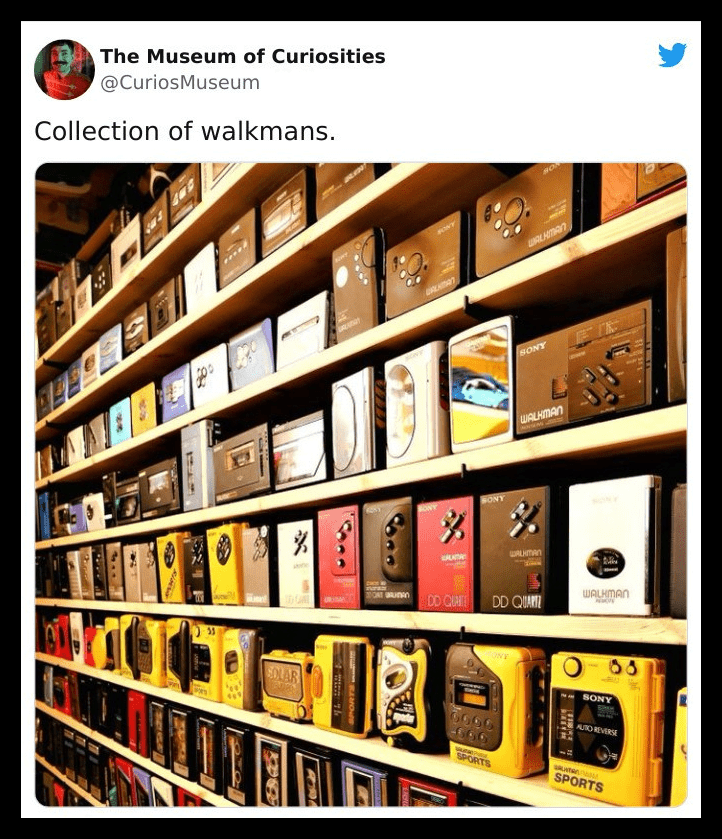
In an attempt to gather all the market versions in one location, underneath one roof, and into one catalog, the individuals behind this collection have attempted the unthinkable. Would love to visit this place, if we knew where this place is.
The Double-wide Limo by Jay Ohrberg
The man known as “The King of Show Cars,” Jay Ohrberg, is the designer of this spectacular limousine. The double-wide limo features twin Cadillac front-wheel drive engines with eight wheels on each side. It is constructed on a unique base. It is about two and a half cars wide.
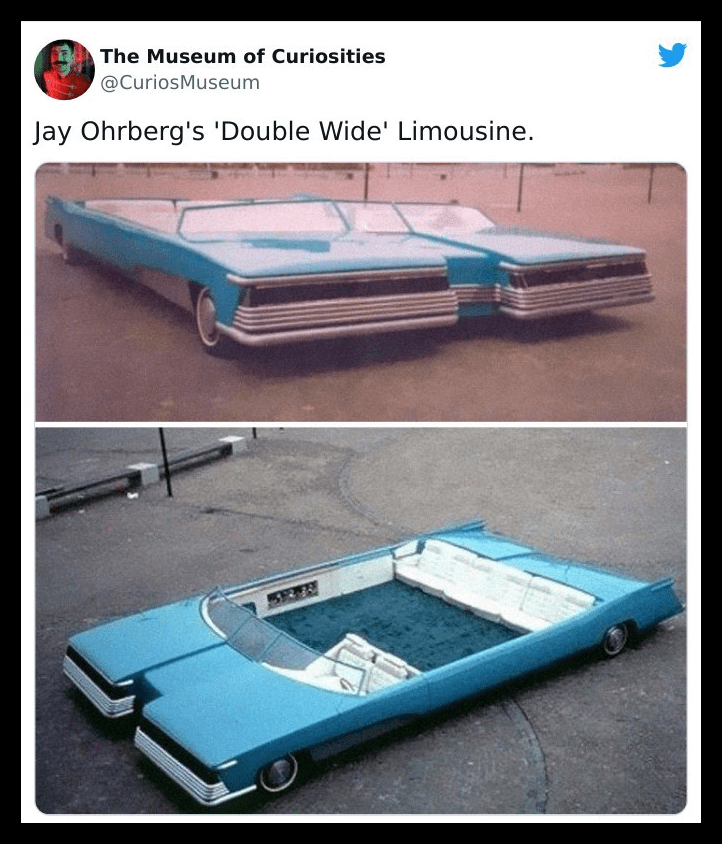
It is just over 30 feet in length. There is a driver’s seat within, as you might anticipate. It is merely a huge, upholstered piece of mechanical marvel. The only additional seating is a double-wide bench seat that is entirely covered in fuzzy white fabric. Talk about riding in style.
“Ritter” road skates from the Victorian era
The very first roller skates are thought to have been created by the Belgian Joseph Merlin in 1760; while sporting his innovative skates at one party held in London, he smashed into a pricey mirror. Iron wheels were on the first skates.
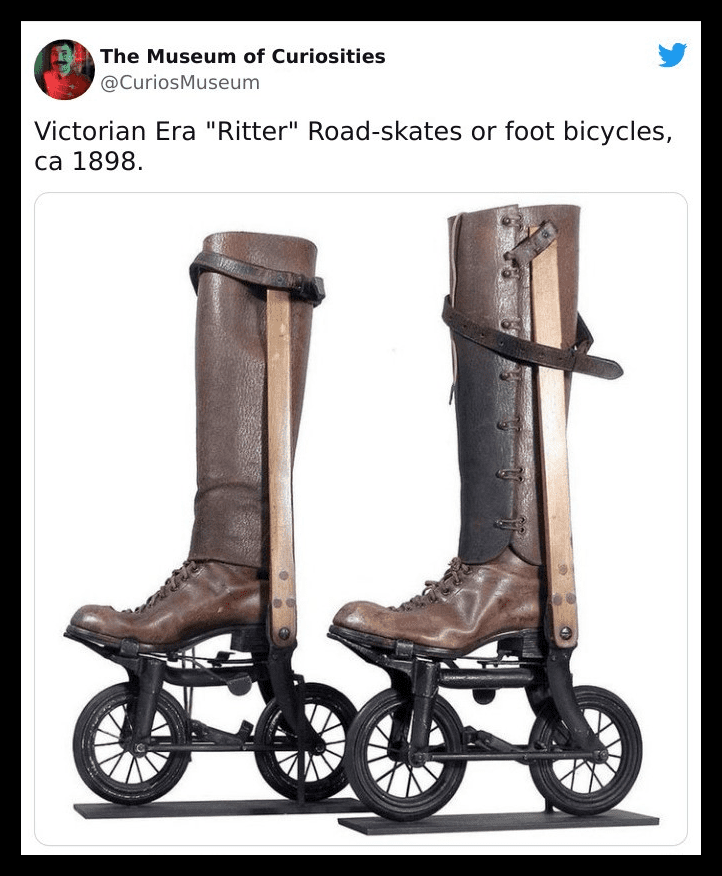
In the 1890s, road skates like the Ritter gained popularity. Road skating evolved into a primarily masculine sport, whereas quad roller skating and ice skating were preferred by women. Though the design of these feels like they’d appear in a retro-futuristic film, don’t you think?
Philco Predicta Television set
This 1959 Philco Predicta “Brazilian” table-type television is incredibly uncommon. Both the foundation and finish of this special Predicta edition, which is similar to the Holiday prototype, are totally different. The golden grille on the toasty oak base has the Philco logo inside the lower left corner.
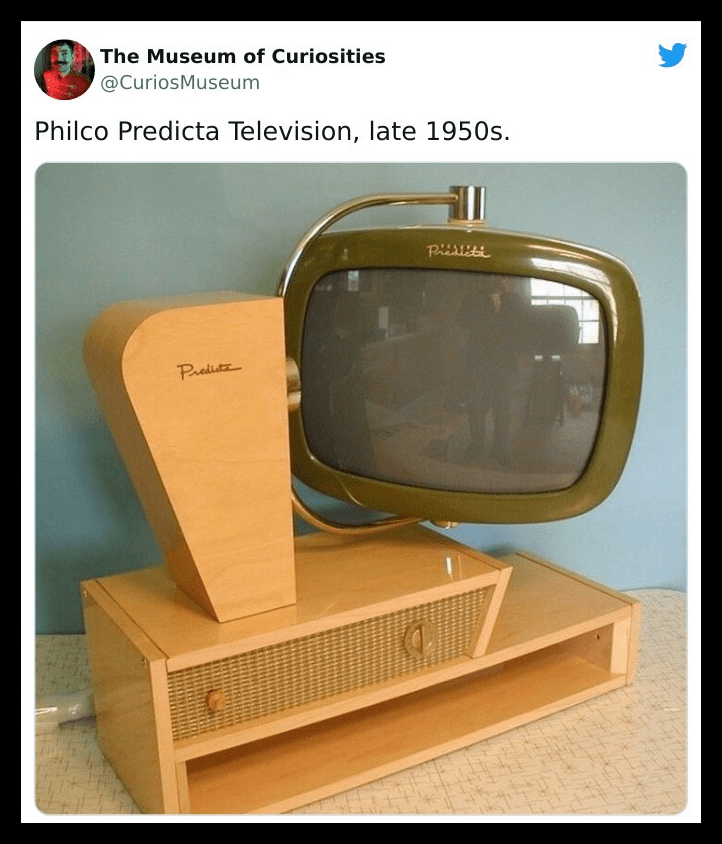
Three adjusting thumb dials are located on the front section of the base’s surface, as well as the tuning select knob is located on the right-hand side. Truly a stunning piece of design. No wonder collectors go crazy over these.
An antique vampire killing kit
Buffy might be one of the greatest vampire slayers, but she wasn’t the first. Vampire mythos date back hundreds of years, but back in the day, they weren’t always considered fictional. Or, perhaps, they were toted by hopeful fanboys who wanted to find a vampire.
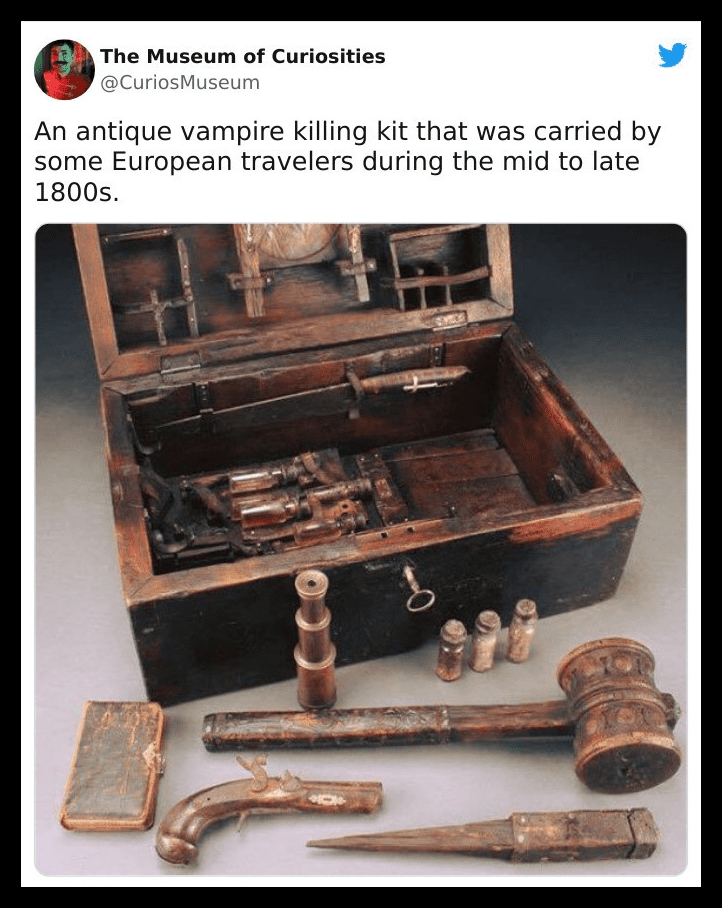
A walnut box with a latched top, including materials like a wooden stake and mallet, cross, revolver, and bottles of garlic powder, was the standard vampire-killing kit that was allegedly hauled throughout Europe by a group of Van Helsing wannabes.
Cat-themed embroidery by Mary, Queen of Scots
We joke about cats and internet culture, but they’ve been a fascination of humans for centuries. And we’re not just talking about the Egyptians. While Mary Queen of Scots was imprisoned, she did some embroidery. What was her inspiration? Cats!
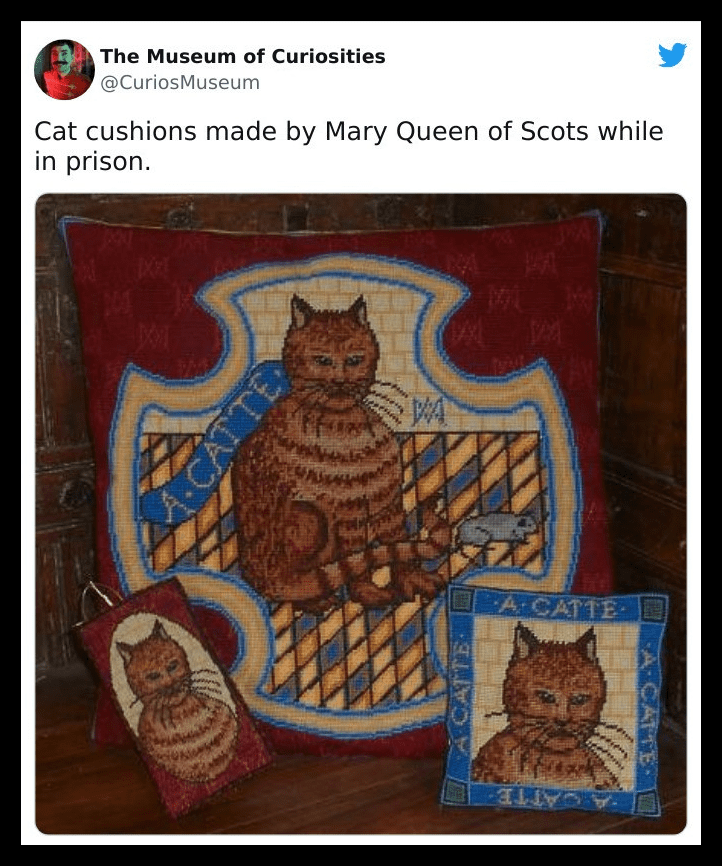
The Royal Collection in London currently has the catte embroidery. Arguably, our favorite detail among these pieces is the tiny embroidered rat in the large piece in the center. Sure, the cat faces seem creepily like human faces, but we can’t fault her for that.
Carving from the Abbey of Saint Foy
Sainte-Foy Abbey was constructed in the Romanesque style featuring elaborate carvings and charming spires. Conques is a cruciform version of a basilica, as are the majority of pilgrimage shrines. To enable movement at the gallery level, galleries were erected above the aisle.
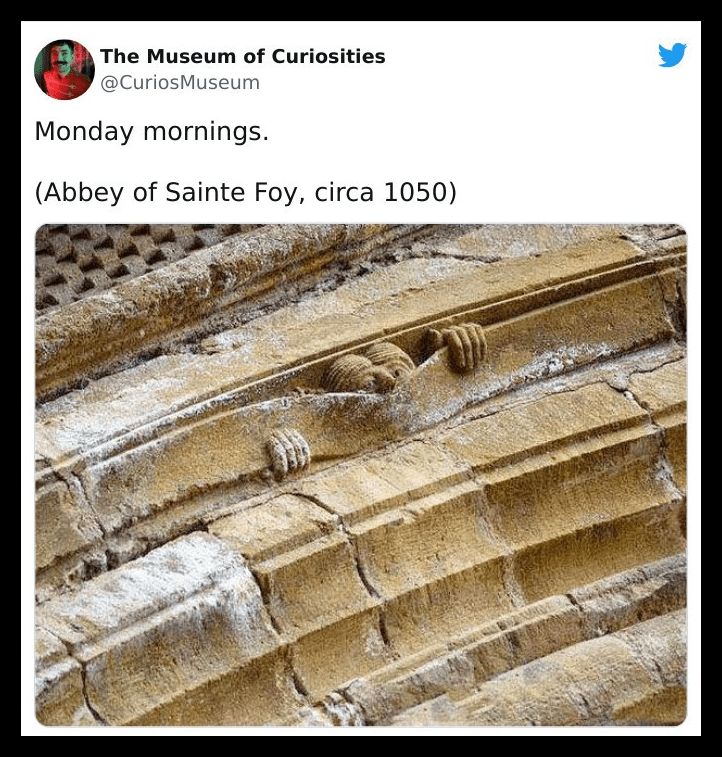
Also, the ceiling was elevated over through the transept and choir. Its stunning Tympanum from the 12th century features a representation of the Last Judgment. Its vault is overflowing with a variety of creations made by goldsmiths as far back as the 9th century.
Art Deco radios from the 1930s
The Art Deco period was the time when the radio truly reached adulthood, despite not having been invented during that time. In that time, two significant events occurred. First was the introduction of periodic radio programming on brand-new radio channels throughout the United States.
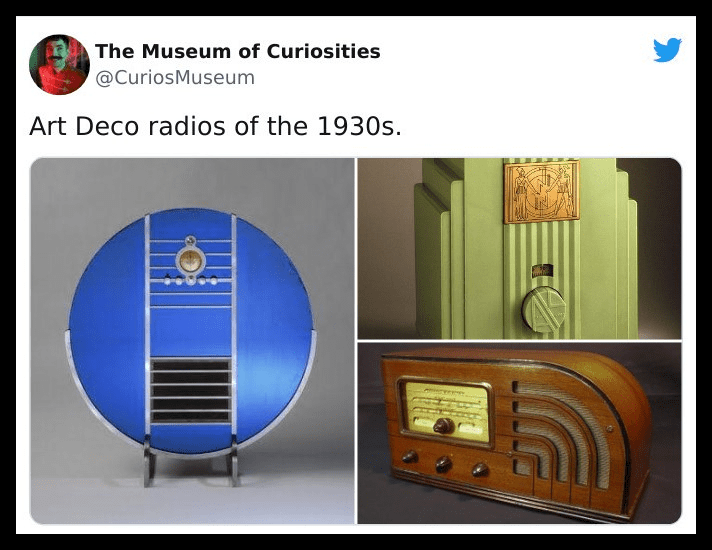
Starting in 1920 at Detroit’s WWJ, whose inaugural transmission featured “Taps” and also the songs “Roses of Picardy” and “Annie Laurie” performed on an Edison phonograph. Later, in 1925, the phrase “Art Deco” was created, borrowing its name from a significant Parisian design exhibition.
Cutlery set designed by Salvador Dalí
Salvador Dalí is renowned for his paintings, such as the famous melting clocks (The Persistence of Memory). However, he was also adept in other mediums, other than paint. This bizarre, likely impractical, cutlery set could only come from the mind of a surrealist artist.
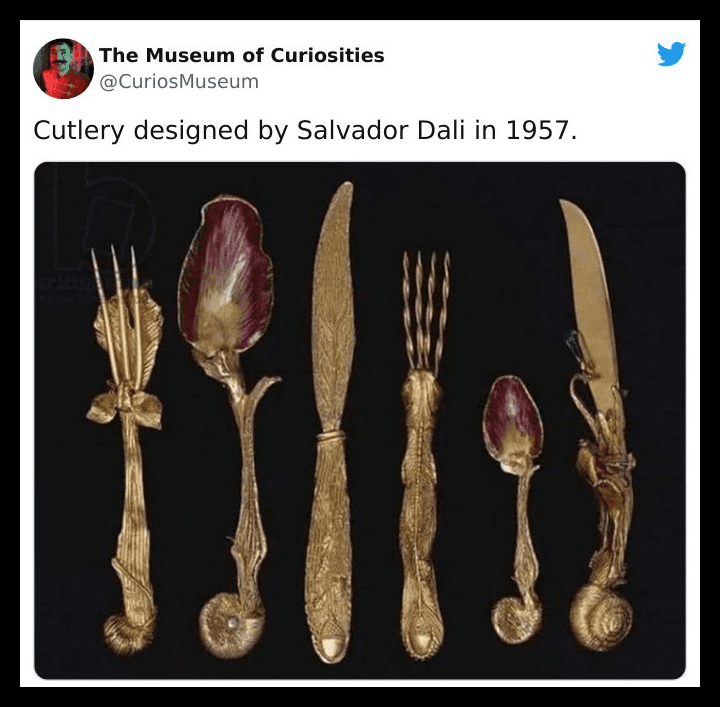
His crafts are somewhat lesser known than his canvases, which are the focus of much of the praise. Dalí has also frequently worked with renowned Parisian interior designer Jean-Michel Frank, with whom they have jointly developed a number of designs.
Toaster from the 1920s
Retro toasters are works of art within and of themselves, echoing the fashions in design and architecture of the time. These cutting-edge household appliances’ once-gleaming metal, as well as steel casings, are evocative of works of art from the Art Nouveau and Art Deco periods.
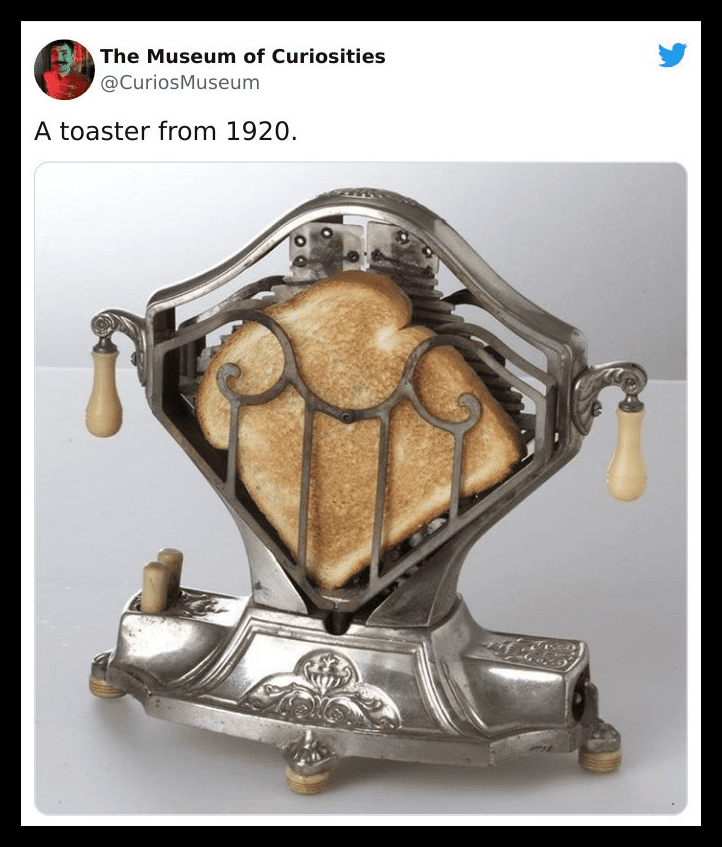
They are so beautiful that their simplicity has been more than made up for. What happened to designs like these? Perhaps those mid-1900s depictions of the future were right. We seem to have given up on style in favor of sleek and simple facades.
Coffeemaker for Volkswagen vehicles
The Hertella Auto Kaffeemaschine für Volkswagen is so uncommon that little is known about it. There are only a few photographs of the pot appearing on the internet, and there is at best only one brochure available online in German.
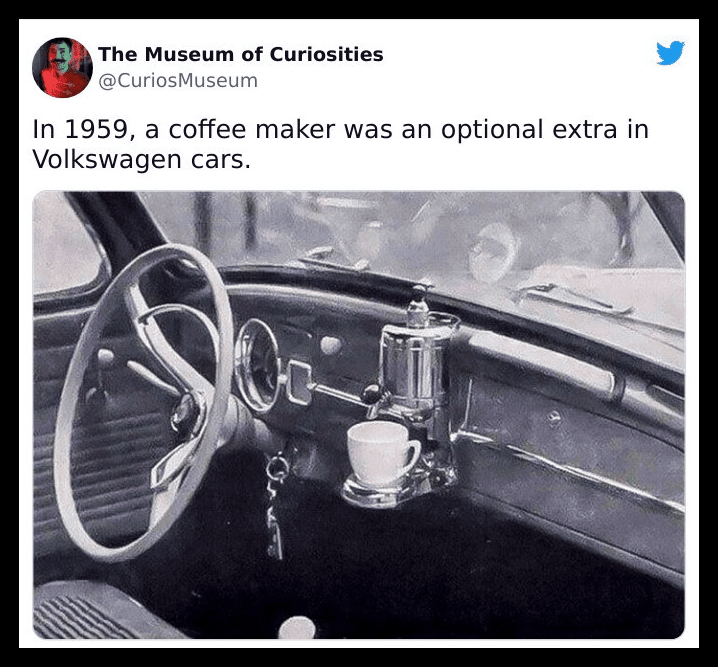
The device lacks a power button. It just becomes hot as soon as you connect it with the cigarette lighter. You would have to be extremely in need of coffee to brew in this device. And as for the kind of coffee maker it is, we have no clue.
Stylish hearse
Hearses have an inherent aura of mystery in American car culture. A hearse is a magnificent work of engineering made to honor the deceased regardless of whether it’s parked on the sidewalk or moving through a crowd during a burial ceremony.
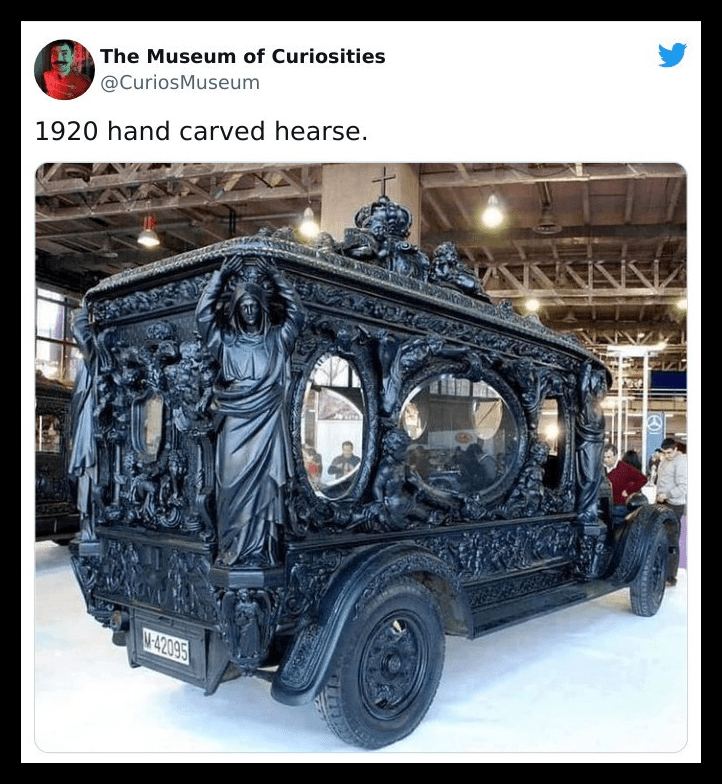
When people are speechless, a hearse sends a message. The elaborate funeral cars created for the International Classic Vehicle Salon in Madrid are remarkable. From that display comes this wonderfully carved 1920s Studebaker. Just look at it. Perfect vehicle for the Addams family.
